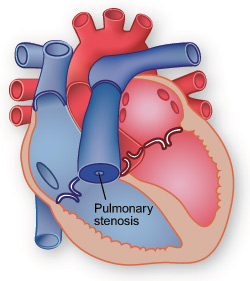Stenosis means narrowing. Pulmonary stenosis is a narrowing of the valve that lets blood flow from the lower-right chamber (the right ventricle) into the lungs. When this valve narrows, the right ventricle has to work harder and it becomes enlarged.
 What are the symptoms?
What are the symptoms?
Many children with mild pulmonary stenosis have no symptoms.
Infants with severe pulmonary stenosis may have a bluish coloring to their skin because not enough oxygen-rich blood is reaching the body. This is called cyanosis.
How is it treated?
Children with mild stenosis usually do not need surgery, but they should be watched carefully as they grow.
If a child is cyanotic (bluish), the valve must be widened right away, either through open heart valve surgery or balloon valvuloplasty. In balloon valvuloplasty, a balloon is guided into the heart on the tip of a long, thin tube called a catheter, then inflated to force the valve to open wider.
Procedures using stents and artificial heart valves may also be used.
After valve surgery or balloon valvuloplasty, the valve sometimes narrows again, so people with pulmonary stenosis should see their doctor regularly.
Return to main topic: Congenital Heart Disease
See on other sites:
MedlinePlus
https://medlineplus.gov/ency/article/001096.htm
Pulmonary Valve Stenosis
American Heart Association
www.heart.org/HEARTORG/Conditions/CongenitalHeartDefects/
AboutCongenitalHeartDefects/Pulmonary-Valve-Stenosis_UCM_307034_Article.jsp
Pulmonary Valve Stenosis
Texas Adult Congenital Heart Center (TACH)
www.bcm.edu/healthcare/care-centers/congenital-heart
This Baylor College of Medicine program enables patients with congenital heart disease to receive a seamless continuation of care from birth to old age.
Updated August 2016



